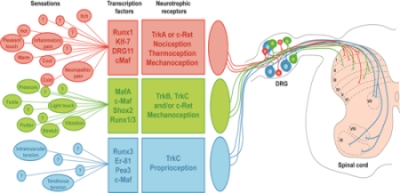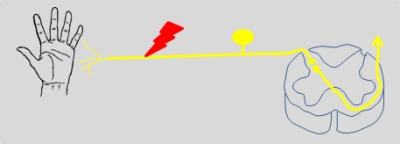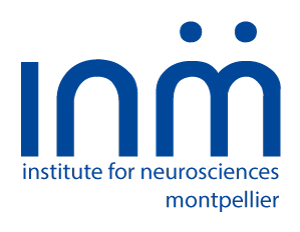Sensation
Sentient animals have the ability to feel touch and painful stimuli, to sense cold and hot, to respond to aversive stimuli by adaptive reflexive movements. These fundamental activities, essential for survival, are encoded by neuronal circuits that link the somatosensory (body sense) and motor systems (appropriate action). We study how these interlinked systems are established during development and how they function in the normal and pathological states.

The ability to detect changes in temperature, noxious stimuli, touch and body position is essential for organisms to respond appropriately to a changing environment. Somatosensory neurons of the dorsal root ganglia (DRG) detect external environmental signals and information from internal organs and convey these signals to the central nervous system where they are integrated into neuronal circuits that control posture, ambulatory movements, motor reflexes and protective responses to injury and disease. Ascending pathways transmit somatosensory information to the brain. Our experimental models range from genetic studies on fruit fly (Drosophila) embryos, chick embryos, primary neurons in culture to behavioural tests on transgenic mice. Deepening our knowledge of these fundamental developmental processes allow us to better understand how different neuron sub-types respond in pathological situations, and to ameliorate the outcome in various types of peripheral neuropathies.

Chronic pain affects around 12 million people in France with the vast majority of patients reports comorbid anxio-depressive disorders. Existing treatments are quiet ineffective. Although their causes are numerous (nociceptive, neuropathic and psychogenic) the post-surgical trauma, are by far the most frequent. Post-traumatic pain, for instance, accounts for 45-50% of the consultations in the centers for evaluation and treatment of pain conditions. By better understanding the molecular and cellular mechanisms supporting the neuroplasticity characterizing chronic pain state, new and more specific therapeutic targets and innovative strategy could emerge to improve chronic pain management.















